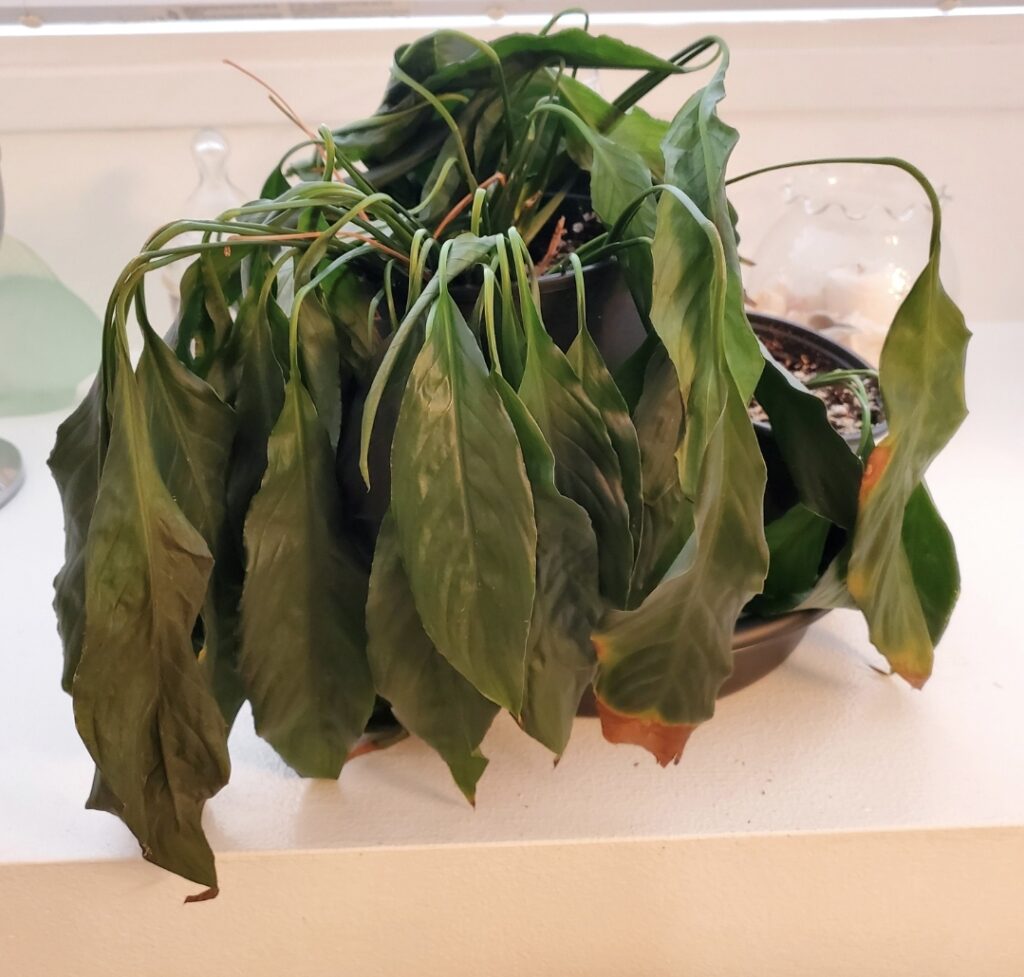
I apologize if you don’t cover indoor plants, but I thought I’d take a chance and ask.
My mother kept a spathiphyllum plant for many, many years, and she has since passed away, so this plant is sentimental to me and I’d really like to save it.
I’m a pretty experienced outdoors gardener, but not always great with indoor plants. I know the greatest danger to indoor plants is overwatering, so I try my best to water only when needed.
However, I know a couple times, Spathy wilted from getting too dry and almost died once from that. Quite a few months ago now, I uppotted it into a pot (I realize now) a bit too big for it, because I’ve had issues with the soil seeming too moist for too long, even with minimal watering. The plant kept staying wilted so last week I figured I needed to check the roots. At the same time, I decided to divide out a couple smaller tubers to give myself backups in case the main plant died, and those seem to be doing really well. The rest of the tubers had root rot, the roots basically just fell right off. The tubers still felt solid though, so I moved them back into a smaller pot with Pro-Mix and lots of extra perlite and gave them a good watering-in thinking maybe the poor plant couldn’t uptake any water due to the roots being damaged. I realize now that this was a bad move, because again the pot just isn’t draining – despite all the perlite I added.
The strange thing is, I’ve never really seen any yellowing or paling of the leaves that would usually indicate overwatering for a long period of time. What I do see are leaves that basically dry out completely and become crispy (the picture I’m attaching shows one such leaf in the front on the left – colour looks normal but it’s completely dried out), or some leaves that get black patches and die. I even saw a new leaf that turned black and died (that was when I decided I needed to look at the roots).
My current plan is to remove the plants not doing well, and repot with drier Pro-Mix into a terracotta pot.
My question is, with all this in mind, is this the best course of action? Is there a way to reset a stressed tuber like drying it out for a couple days and replanting, or would that lack of moisture kill it? I’m not sure how long they can go without water so I’m hesitant to try that. I know I’ve already really stressed the plant out but I didn’t see any other option and am now worried I’m going to waterlog the tubers in the current pot.
Sorry for the novel, I just wanted to give as much detail as possible so you know what I’ve tried.
Hello and welcome to Master Gardeners of Toronto. We are happy to provide scientifically based advice on both indoor and outdoor plants.
First, we appreciate the detailed history you have provided. It’s clear you have experience with plants even if most of it is for outdoor gardening.
Peace lilies, (Spathiphyllum), thrive in bright filtered light, well-drained fertile soil, and average room temperatures. For healthy growth, water the plant when the soil partly dries out.
The first concern you expressed is about the soil not seeming to dry out or doing so very slowly. You don’t mention if there is a drainage hole in the bottom of the pot. It’s not uncommon for people to use pots without holes for use inside to protect their furniture. The pot needs at least one hole to be able to drain. Placing it on a saucer will protect your home while allowing the plant to drain properly. A good description of this can be found here.
Secondly, be aware that not all soils are the same with or without the addition of perlite. You mentioned Pro-mix but that is just a brand name. Check to make sure you are using a container soil, or one specifically designed for house plants, NOT “potting soil”. In this case you might want to try using “Cactus and Succulent soil” as it has superior draining properties. An excellent resource for soils, non-soil alternatives and re-potting can be found here
Your decision to repot and inspect the roots(rhizomes) was a wise one as was the recognition that you may have used too large of a pot. This point brings us to your question about “re-setting” a plant. The repairs you have made to the root system are about all you can do. Removing the dead roots and refreshing the soil are about the limit of anything that looks like a re-set. Leaving it out runs the risk of over drying again. Better to use clean, fresh medium (or soil) to repot (in the correct sized pot)
You also mention crispy leaves which were probably caused by the times it went dry too long. Make sure the plant is not located too close to a window, vent or air return. A subtle draft that we barely notice can have a great impact on a plant.
Symptoms and advice on helping overwatered plants can be found here.
Good luck with your Mom’s plant!

